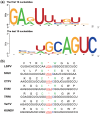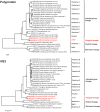Newly identified viral genomes in pangolins with fatal disease
- PMID: 32296543
- PMCID: PMC7151644
- DOI: 10.1093/ve/veaa020
Newly identified viral genomes in pangolins with fatal disease
Abstract
Epizootic pathogens pose a major threat to many wildlife species, particularly in the context of rapidly changing environments. Pangolins (order Pholidota) are highly threatened mammals, in large part due to the trade in illegal wildlife. During July to August 2018 four sick wild pangolins (three Manis javanica and one Manis pentadactyla) exhibiting a variety of clinical symptoms were rescued by the Jinhua Wildlife Protection Station in Zhejiang province, China. Although three of these animals died, fortunately one recovered after 2 weeks of symptomatic treatment. Using meta-transcriptomics combined with reverse transcription polymerase chain reaction (RT-PCR), we identified two novel RNA viruses in two of the dead pangolins. Genomic analysis revealed that these viruses were most closely related to pestiviruses and coltiviruses, although still highly genetically distinct, with more than 48 and 25 per cent sequence divergence at the amino acid level, respectively. We named these Dongyang pangolin virus (DYPV) and Lishui pangolin virus (LSPV) based on the sampling site and hosts. Although coltiviruses (LSPV) are known to be transmitted by ticks, we found no evidence of LSPV in ticks sampled close to where the pangolins were collected. In addition, although DYPV was present in nymph ticks (Amblyomma javanense) collected from a diseased pangolin, they were not found in the local tick population. Epidemiological investigation revealed that both novel viruses might have been imported following the illegal international trade of pangolins. Hence, these data indicate that illegal wildlife trafficking not only threatens the status of pangolin populations, but may also spread epizootic pathogens.
Keywords: Pangolins; coltivirus; fatal disease; illegal wildlife trade; pestivirus.
© The Author(s) 2020. Published by Oxford University Press.
Figures






Similar articles
-
Detection of a novel Pestivirus strain in Java ticks (Amblyomma javanense) and the hosts Malayan pangolin (Manis javanica) and Chinese pangolin (Manis pentadactyla).Front Microbiol. 2022 Sep 2;13:988730. doi: 10.3389/fmicb.2022.988730. eCollection 2022. Front Microbiol. 2022. PMID: 36118205 Free PMC article.
-
Evidence of SARS-CoV-2 Related Coronaviruses Circulating in Sunda pangolins (Manis javanica) Confiscated From the Illegal Wildlife Trade in Viet Nam.Front Public Health. 2022 Mar 9;10:826116. doi: 10.3389/fpubh.2022.826116. eCollection 2022. Front Public Health. 2022. PMID: 35356028 Free PMC article.
-
Surveillance of ticks and associated pathogens in free-ranging Formosan pangolins (Manis pentadactyla pentadactyla).Ticks Tick Borne Dis. 2016 Oct;7(6):1238-1244. doi: 10.1016/j.ttbdis.2016.07.007. Epub 2016 Jul 10. Ticks Tick Borne Dis. 2016. PMID: 27426438
-
To Save Pangolins: A Nutritional Perspective.Animals (Basel). 2022 Nov 14;12(22):3137. doi: 10.3390/ani12223137. Animals (Basel). 2022. PMID: 36428365 Free PMC article. Review.
-
Where are you hiding the pangolins? screening tools to detect illicit contraband at international borders and their adaptability for illegal wildlife trafficking.PLoS One. 2024 Apr 3;19(4):e0299152. doi: 10.1371/journal.pone.0299152. eCollection 2024. PLoS One. 2024. PMID: 38568991 Free PMC article. Review.
Cited by
-
Detection of a novel Pestivirus strain in Java ticks (Amblyomma javanense) and the hosts Malayan pangolin (Manis javanica) and Chinese pangolin (Manis pentadactyla).Front Microbiol. 2022 Sep 2;13:988730. doi: 10.3389/fmicb.2022.988730. eCollection 2022. Front Microbiol. 2022. PMID: 36118205 Free PMC article.
-
Positively Charged Amino Acids in the Pestiviral Erns Control Cell Entry, Endoribonuclease Activity and Innate Immune Evasion.Viruses. 2021 Aug 10;13(8):1581. doi: 10.3390/v13081581. Viruses. 2021. PMID: 34452446 Free PMC article.
-
Virome in healthy pangolins reveals compatibility with multiple potentially zoonotic viruses.Zool Res. 2022 Nov 18;43(6):977-988. doi: 10.24272/j.issn.2095-8137.2022.246. Zool Res. 2022. PMID: 36257829 Free PMC article.
-
New Emergence of the Novel Pestivirus Linda Virus in a Pig Farm in Carinthia, Austria.Viruses. 2022 Feb 5;14(2):326. doi: 10.3390/v14020326. Viruses. 2022. PMID: 35215920 Free PMC article.
-
Trafficked Malayan pangolins contain viral pathogens of humans.Nat Microbiol. 2022 Aug;7(8):1259-1269. doi: 10.1038/s41564-022-01181-1. Epub 2022 Aug 2. Nat Microbiol. 2022. PMID: 35918420 Free PMC article.
References
-
- Asplund M. et al. (2019) ‘Contaminating Viral Sequences in High-Throughput Sequencing Viromics: A Linkage Study of 700 Sequencing Libraries’, Clinical Microbiology and Infection, 25: 1277–85. - PubMed
LinkOut - more resources
Full Text Sources

